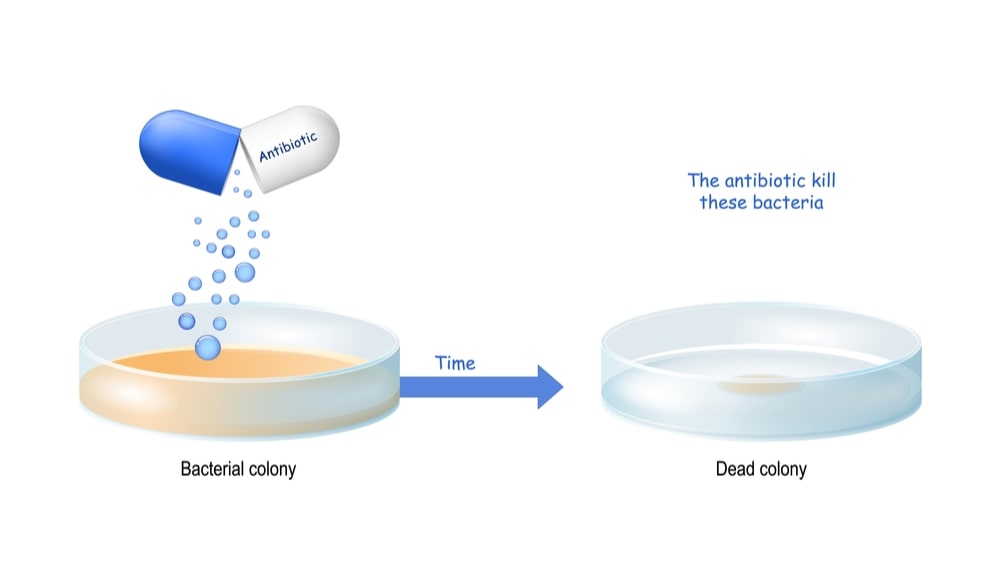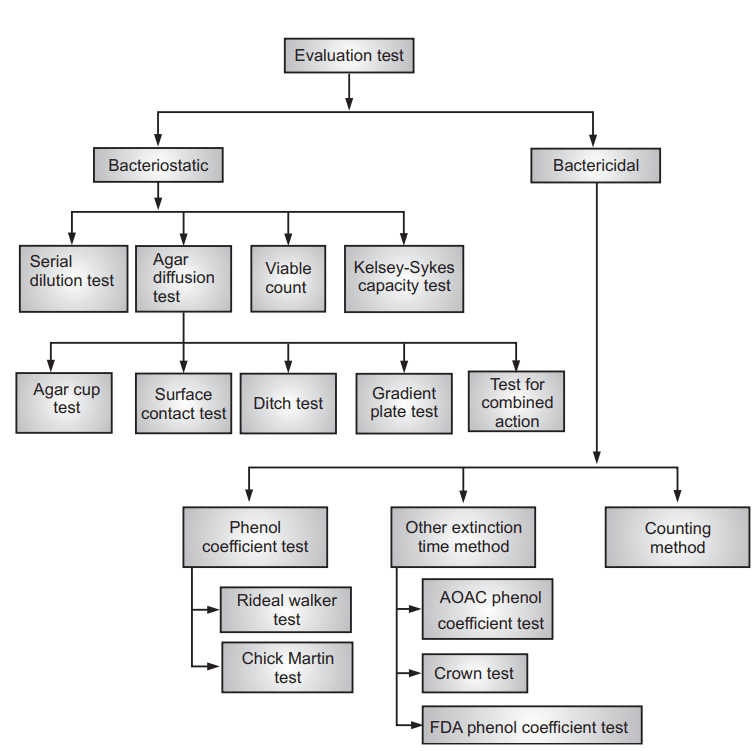Table of Contents
In-vitro test:
This test is carried out to know the antibiotic susceptibility. Because many bacteria have unpredictable susceptibilities to antimicrobial agents, it is measured by the MIC method. Susceptibility means the microorganism is inhibited by a concentration of antimicrobial agent that can be attained in blood with the normally recommended dose of the antimicrobial agent.
Determination of MIC (Minimum Inhibitory Concentration):
It is the lowest concentration of disinfectant that will inhibit the growth of a microbe in culture. Similar to test-tube serial dilution used in antibiotic susceptibility test (Fig. 1.1). This test is performed using Mueller Hinton Agar (MHA) medium because it has good reproducibility, low in sulfonamide, trimethoprim, and tetracycline inhibitors. It gives satisfactory growth of most bacterial pathogens. The MIC is carried out by various methods, (A) the Serial dilution method and (B) the Agar diffusion method. But serial dilution method is more advantageous because:
- The method evaluates the agent against many microorganisms at once.
- Turbid agents are evaluated by this method.
- It is most suitable for the evaluation of antifungal agents.
- It is easy to detect resistance cells.
Procedure:
Prepared graded doses of test substance (disinfectant) as well as stock solution of antibiotics by the following formula:
1000/P×V×C = W
where,
P = Potency (mcg/mg),
V = Volume required,
C = Final concentration of solution,
W = Weight of antibiotic (mg)
- To this added suitable liquid medium e.g. Nutrient Broth or MHA medium.
- Aseptically distributed 1 ml of double-strength nutrient broth into each tube.
- 1 ml of antibiotic is added to the first tube then transfer 1 ml from the first tube to the next tube and repeated up to the last tube.
- Tubes are inoculated with 0.5 ml of the standardized test organism (McFarland standard: 0.5 ml of 0.048 M barium chloride is added to 99.5 ml of 0.18 M sulphuric acid).
- Tubes were incubated at the appropriate temperature at 37°C for 24 hours.
- Finally, turbidity is measured.
Example: In case of broth dilution, 2 fold dilutions: 1, 2, 4, 8, 16, 32, 64, 128 mcg/ml, now up to 4 mcg/ml there are growth of organism and from 8 to 128 mcg/ml no growth, then MIC = 8 mcg/ml.
Minimum Bactericidal Concentration (MBC):
It is the lowest concentration of the antimicrobial agent that kills 99.9% of the test organism.
Procedure:
- A pure culture of a specified microorganism is grown overnight, then diluted in growth-supporting broth (typically Mueller Hinton Broth) to a concentration between 1 × 105 and 1 × 106 CFU/ml.
- A stock dilution of the antimicrobial test substance is made.
- Further 1: 1 dilutions are made in test tubes.
- All dilutions of the test product(s) are inoculated with equal volumes of the specified microorganism.
- A positive and negative control tube or well is included for every test microorganism to demonstrate adequate microbial growth over the course of the incubation period and media sterility, respectively.
- An aliquot of the positive control is plated and used to establish a baseline concentration of the microorganism used.
- The tubes are then incubated at the appropriate time and temperature.
- Turbidity indicates the growth of the microorganism and the MIC is the lowest concentration where no growth is visually observed.
- To determine the MBC, the dilution representing the MIC and at least two of the more concentrated test product dilutions are plated and enumerated to determine viable CFU/ml.
- The MBC is the lowest concentration that indicated a pre-determined reduction (such as 99.9%) in CFU/ml when compared to the MIC dilution.
Example: In case of broth dilution, 2 fold dilutions: 1, 2, 4, 8, 16, 32, 64, 128 mcg/ml, now up to 16 mcg/ml there are growth of organism and from 32 to 128 mcg/ml no growth, then MBC = 32 mcg/ml.
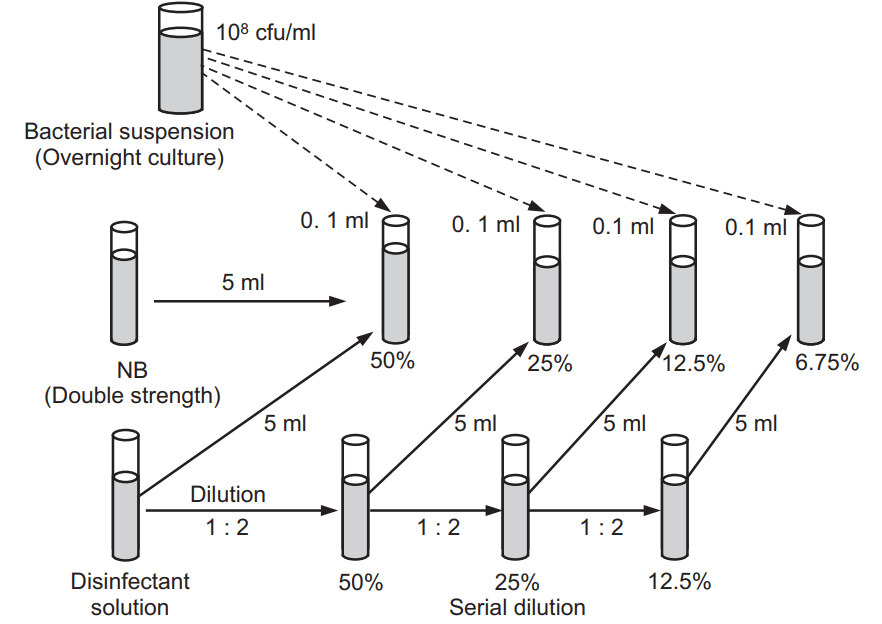
Bactericidal:
They are the agents that disrupt the cell wall synthesis and kill the bacteria. They are less reliant on host resistance. They have more flexibility with dosage intervals and are hence more powerful than statin drugs. MBC is mainly done for bactericidal activity. It is defined as the minimum concentration of the drug or antibiotic that kills the given test organism. Examples: Penicillins, and cephalosporins.
Bacteriostatic:
They are the agents that inhibit the RNA synthesis or reproduction and hence inhibit the growth and reproduction of bacteria. They help the host defenses to take over. MIC is mainly done for bacteriostatic activity. MIC is defined as the lowest concentration of drug or antibiotics that inhibits the growth of the test organism. Examples: Tetracyclines, chloramphenicol, Trimethoprim.
Some other examples of bacteriostatic and bactericidal drugs are given below
Table 1.1.
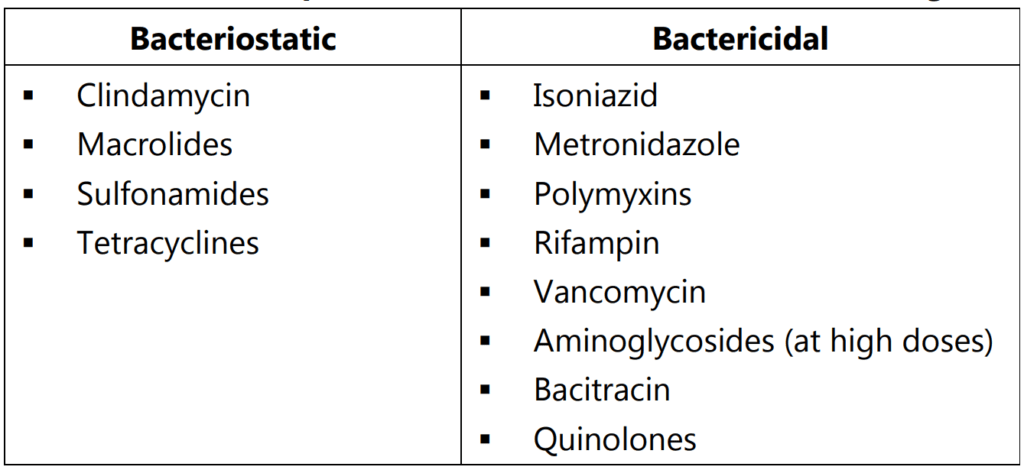
The figure below indicates that when antibacterial drugs are added at a particular time it
affects either removal or killing action based on the nature of the drugs (Fig. 1.2).
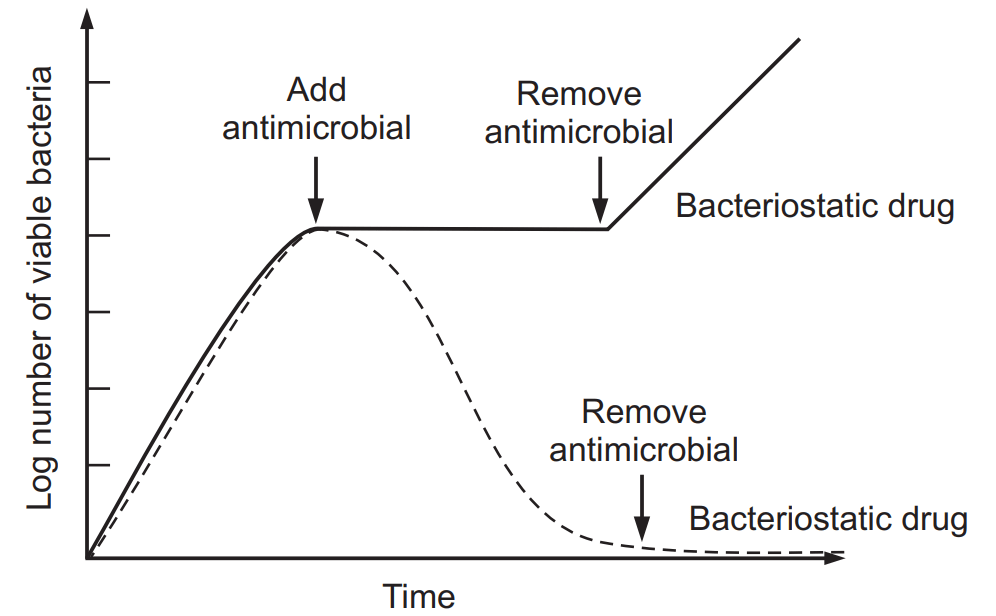
All the methods are used for the disinfection of various types of substances. In particular evaluation, tests are carried out for what type of substances is listed in Table 1.2.
The organisms are used in ATCC grade which stands for the “American Type Culture Collection”. It is a non-profit organization that collects, stores, and distributes standard reference microorganisms, cell lines, and other materials for research and development. Another type is NCTC, “The National Collection of Type Cultures”. They supply reference bacterial cultures, including any type of strains, of medical, scientific, and veterinary importance worldwide. Examples: E. coli: NCTC 8196 (ATCC 11229); Staphylococcus aureus NCTC 4163 (ATCC 6538) etc. Antibiotic Susceptibility Test.

Make sure you also check our other amazing Article on : Electron Microscopy
